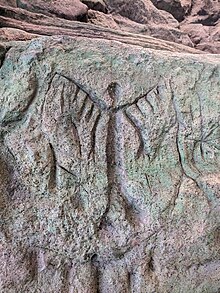Fugoppe Cave is an archaeological site in Hokkaido, Japan, dating from the Jōmon period. It is located on a hillside known as Maruyama in the town of Yoichi. Along with the nearby Temiya Cave in Otaru City, it is one of only two significant petroglyph sites in Japan.

There are around 800 figures carved into the rock of the cave. Many are human figures, some of which have wings or horns. The site has been dated to between 100 and 400 A.D., based on excavations and geological data. The cave itself is around 7m deep and made of soft hyaloclastite, which is why the figures could be carved by abrasion and then polished.

See also
References
- ^ Ogawa, Masaru (2019). "Rock Art in Japan". In Clottes, Jean; Smith, Benjamin (eds.). Rock Art in East Asia (PDF). Charenton-le-Pont, France: International Council on Monuments and Sites. p. 32. ISBN 978-2-918086-27-7. Retrieved 28 September 2023.
43°11′41″N 140°50′19″E / 43.1946°N 140.8387°E / 43.1946; 140.8387
This article relating to archaeology is a stub. You can help Misplaced Pages by expanding it. |